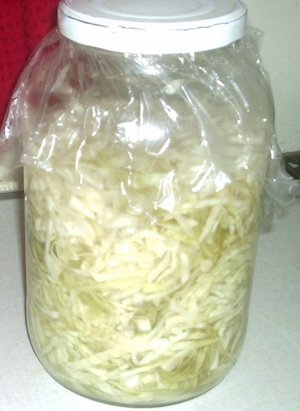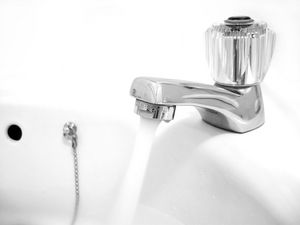Sauerkraut is the German word for “sour cabbage” and is shredded cabbage that has been fermented by various lactic acid bacteria, which gives it its sour flavor as it ferments with the sugar present on the cabbage. This is the pickling process that allows sauerkraut to be stored for months — storing it in airtight containers at temperatures below 59° F with or without pasteurization will prolong the life of the sauerkraut even longer.
Raw sauerkraut has many health benefits, such as being an excellent source of vitamin C, lactobacilli, and other nutrients, as well as creating high levels of anti-cancer agents.
Before foods were able to be frozen and shipped over long distances, sauerkraut was one of the major foods shipped. Sauerkraut was also used by sailors to provide the proper nutrients during months long journeys without stops to pick up supplies. Captain James Cook had a supply of sauerkraut on all of his sailing voyages to prevent the ailment of scurvy, which is caused by a lack of vitamin C. Soon after that, German sailors used sauerkraut on their journeys. The English navy men changed to using limes, hence their being called “Limeys” and German navy men “Krauts.”
I was always curious about how sauerkraut was made. It is sour so I thought that it contained vinegar. My curiosity got the better of me a few months ago and I actually read the ingredients label on a bag of store-bought sauerkraut and, to my astonishment, I saw no vinegar! I just had to do a little research online and found out that the sourness of sauerkraut comes from the bacteria on the cabbage itself — who knew? I have a very big curiosity and I just had to make my own sauerkraut.
We make sauerkraut based on the bacteria present on the cabbage leaves and use salt to draw out the water and kill another kind of bacteria that causes spoilage. You generally want a salt to cabbage concentration of between 0.6% and 2% or 3/4 to 2 teaspoons of salt per pound of cabbage.
The key to making the perfect sauerkraut lies in the temperature. It is very important that you maintain the proper temperature conditions and consistently because there is a fine line between fermentation and spoilage. Most sources say that the cabbage should be stored at temperatures between 55° F and 76° F. Temperatures below 55° will prevent fermentation from ever beginning and temperatures above 76° will cause excessive yeast to form and the sauerkraut will become soft, result in a bad flavor, and eventually spoil. So, unless you want mushy sauerkraut, always store the cabbage within the 55° and 76° range during the fermentation process.
On with the recipe!
Ingredients
1 gallon-size jar, sterilized with hot water
1 medium head of cabbage, shredded (about 3 pounds)
6 teaspoons salt
3 cups water, at room temperature
Directions
Shred the cabbage into long strips approximately 1/8 inch thick and 1/4 inch wide with a knife or slicer. A food processor can be used but be careful not to dice the cabbage too much because you want long strips.
Put the shredded cabbage into the jar, packing it down tight.
Mix the water and the salt together and pour it into the jar on top of the cabbage slowly until it flows through to the bottom. There should be enough salt water to reach near the top of the cabbage. (If more salt water is needed, remember to maintain the 2 teaspoons of salt per pound of cabbage ratio when adding more water.)
Put a lid on the jar but make sure that it’s not completely airtight because you want the sauerkraut to breathe and ferment.
Store the jar of cabbage at temperatures between 55°F and 76°F for 2-3 weeks or longer if you want stronger sour-flavored sauerkraut.
Check the sauerkraut every day or two to make sure everything is in order and nothing is spoiling. You can start tasting it after two weeks every few days until it is to your liking.
Tips & Suggestions
Be sure to store the jar of cabbage in a location far away from where people will go because the smell can be quite strong and unpleasant.
Sometimes a white foam or scum will form on the top surface of the cabbage and brine. This is harmless and can be skimmed off but don’t let it stay there or it will make the cabbage soft and with a less than desirable flavor.
If you find that your cabbage already has a lot of moisture to begin with, you can place a heavy glass plate on top of the cabbage in the jar with some weights to press down on the cabbage. You might not need any water but remember the 2 teaspoons of salt per pound of cabbage rule.
Do not store the jar of sauerkraut at temperatures below 55° or over 76º because it will interfere with the fermentation and the cabbage will spoil.
If you find that the sauerkraut is too tough and crunchy, you can cook it over medium heat, bring to a boil, and continue cooking for about 10-15 minutes until the sauerkraut is tender enough for your liking. If you plan on cooking something with the sauerkraut, then you don’t need to worry about this step because it will probably cook thoroughly with whatever recipe you are using.
Sources: Wikipedia



